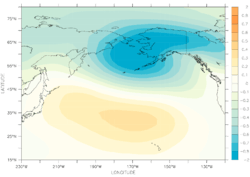North Pacific Oscillation

The North Pacific Oscillation (NPO) is a teleconnection pattern first described by Walker and Bliss[1] and characterized by a north-south seesaw in sea level pressure over the North Pacific.
Rogers, using surface atmospheric temperature from St. Paul, Alaska and Edmonton, identified two phases of the NPO, an Aleutian below (AB) phase that correspond to a deepened and eastward shifted Aleutian low and an Aleutian above (AA) phase that is the opposite.[2]
During the positive (AB) phase sea level pressure is enhanced over a large region in the subtropics that extend poleward to 40N° and reduced at higher latitudes, westerlies are enhanced over the central Pacific and winter temperature are mild along much of the North America west coast but cooler than usual over Eastern Siberia and the United States South-West, precipitations are higher than usual over Alaska and the Great Plains.
[3]
The NPGO is the oceanic expression of the NPO.[4]
References
- ↑ Walker, Gilbert T.; E.W. Bliss (1932). "World weather V" (PDF). Memoirs of the Royal Meteorological Society. 4: 53–84. Retrieved 2010-10-09.
- ↑ Rogers, Jeffery C. (1981). "The North Pacific Oscillation". International Journal of Climatology. 1 (1): 39–57. doi:10.1002/joc.3370010106.
- ↑ Linkin, Megan E.; Sumant Nigam (2008). "The North Pacific Oscillation–West Pacific Teleconnection Pattern: Mature-Phase Structure and Winter Impacts". Journal of Climate. 21 (9): 1979–1997. doi:10.1175/2007JCLI2048.1. Retrieved 2010-10-09.
- ↑ Ceballos, Lina; Emanuele Di Lorenzo; Carlos D. Hoyos; Niklas Schneider; Bunmei Taguchi (2009). "North Pacific Gyre Oscillation Synchronizes Climate Fluctuations in the Eastern and Western Boundary Systems". Journal of Climate. 22 (19): 5163–5174. doi:10.1175/2009JCLI2848.1. Retrieved 2010-10-07.